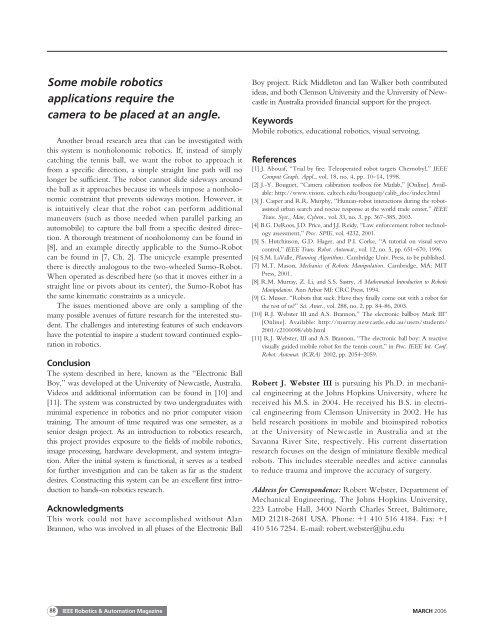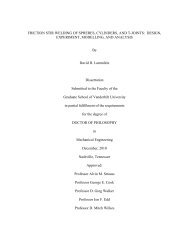Object Capture with a Camera-Mobile Robot System - IEEE Xplore
Object Capture with a Camera-Mobile Robot System - IEEE Xplore
Object Capture with a Camera-Mobile Robot System - IEEE Xplore
You also want an ePaper? Increase the reach of your titles
YUMPU automatically turns print PDFs into web optimized ePapers that Google loves.
Some mobile robotics<br />
applications require the<br />
camera to be placed at an angle.<br />
Another broad research area that can be investigated <strong>with</strong><br />
this system is nonholonomic robotics. If, instead of simply<br />
catching the tennis ball, we want the robot to approach it<br />
from a specific direction, a simple straight line path will no<br />
longer be sufficient. The robot cannot slide sideways around<br />
the ball as it approaches because its wheels impose a nonholonomic<br />
constraint that prevents sideways motion. However, it<br />
is intuitively clear that the robot can perform additional<br />
maneuvers (such as those needed when parallel parking an<br />
automobile) to capture the ball from a specific desired direction.<br />
A thorough treatment of nonholonomy can be found in<br />
[8], and an example directly applicable to the Sumo-<strong>Robot</strong><br />
can be found in [7, Ch. 2]. The unicycle example presented<br />
there is directly analogous to the two-wheeled Sumo-<strong>Robot</strong>.<br />
When operated as described here (so that it moves either in a<br />
straight line or pivots about its center), the Sumo-<strong>Robot</strong> has<br />
the same kinematic constraints as a unicycle.<br />
The issues mentioned above are only a sampling of the<br />
many possible avenues of future research for the interested student.<br />
The challenges and interesting features of such endeavors<br />
have the potential to inspire a student toward continued exploration<br />
in robotics.<br />
Conclusion<br />
The system described in here, known as the “Electronic Ball<br />
Boy,” was developed at the University of Newcastle, Australia.<br />
Videos and additional information can be found in [10] and<br />
[11]. The system was constructed by two undergraduates <strong>with</strong><br />
minimal experience in robotics and no prior computer vision<br />
training. The amount of time required was one semester, as a<br />
senior design project. As an introduction to robotics research,<br />
this project provides exposure to the fields of mobile robotics,<br />
image processing, hardware development, and system integration.<br />
After the initial system is functional, it serves as a testbed<br />
for further investigation and can be taken as far as the student<br />
desires. Constructing this system can be an excellent first introduction<br />
to hands-on robotics research.<br />
Acknowledgments<br />
This work could not have accomplished <strong>with</strong>out Alan<br />
Brannon, who was involved in all phases of the Electronic Ball<br />
Boy project. Rick Middleton and Ian Walker both contributed<br />
ideas, and both Clemson University and the University of Newcastle<br />
in Australia provided financial support for the project.<br />
Keywords<br />
<strong>Mobile</strong> robotics, educational robotics, visual servoing.<br />
References<br />
[1] J. Abouaf, “Trial by fire: Teleoperated robot targets Chernobyl,” <strong>IEEE</strong><br />
Comput Graph. Appl., vol. 18, no. 4, pp. 10–14, 1998.<br />
[2] J.-Y. Bouguet, “<strong>Camera</strong> calibration toolbox for Matlab,” [Online]. Available:<br />
http://www.vision. caltech.edu/bouguetj/calib_doc/index.html<br />
[3] J. Casper and R.R. Murphy, “Human-robot interactions during the robotassisted<br />
urban search and rescue response at the world trade center,” <strong>IEEE</strong><br />
Trans. Syst., Man, Cybern., vol. 33, no. 3, pp. 367–385, 2003.<br />
[4] B.G. DeRoos, J.D. Price, and J.J. Reidy, “Law enforcement robot technology<br />
assessment,” Proc. SPIE, vol. 4232, 2001.<br />
[5] S. Hutchinson, G.D. Hager, and P.I. Corke, “A tutorial on visual servo<br />
control,” <strong>IEEE</strong> Trans. <strong>Robot</strong>. Automat., vol. 12, no. 5, pp. 651–670, 1996.<br />
[6] S.M. LaValle, Planning Algorithms. Cambridge Univ. Press, to be published.<br />
[7] M.T. Mason, Mechanics of <strong>Robot</strong>ic Manipulation. Cambridge, MA: MIT<br />
Press, 2001.<br />
[8] R.M. Murray, Z. Li, and S.S. Sastry, A Mathematical Introduction to <strong>Robot</strong>ic<br />
Manipulation. Ann Arbor MI: CRC Press, 1994.<br />
[9] G. Musser, “<strong>Robot</strong>s that suck. Have they finally come out <strong>with</strong> a robot for<br />
the rest of us?” Sci. Amer., vol. 288, no. 2, pp. 84–86, 2003.<br />
[10] R.J. Webster III and A.S. Brannon,” The electronic ballboy Mark III“<br />
[Online]. Available: http://murray.newcastle.edu.au/users/students/<br />
2001/c2100098/ebb.html<br />
[11] R.J. Webster, III and A.S. Brannon, “The electronic ball boy: A reactive<br />
visually guided mobile robot for the tennis court,” in Proc. <strong>IEEE</strong> Int. Conf.<br />
<strong>Robot</strong>. Automat. (ICRA) 2002, pp. 2054–2059.<br />
Robert J. Webster III is pursuing his Ph.D. in mechanical<br />
engineering at the Johns Hopkins University, where he<br />
received his M.S. in 2004. He received his B.S. in electrical<br />
engineering from Clemson University in 2002. He has<br />
held research positions in mobile and bioinspired robotics<br />
at the University of Newcastle in Australia and at the<br />
Savanna River Site, respectively. His current dissertation<br />
research focuses on the design of miniature flexible medical<br />
robots. This includes steerable needles and active cannulas<br />
to reduce trauma and improve the accuracy of surgery.<br />
Address for Correspondence: Robert Webster, Department of<br />
Mechanical Engineering, The Johns Hopkins University,<br />
223 Latrobe Hall, 3400 North Charles Street, Baltimore,<br />
MD 21218-2681 USA. Phone: +1 410 516 4184. Fax: +1<br />
410 516 7254. E-mail: robert.webster@jhu.edu<br />
88<br />
<strong>IEEE</strong> <strong>Robot</strong>ics & Automation Magazine MARCH 2006
















